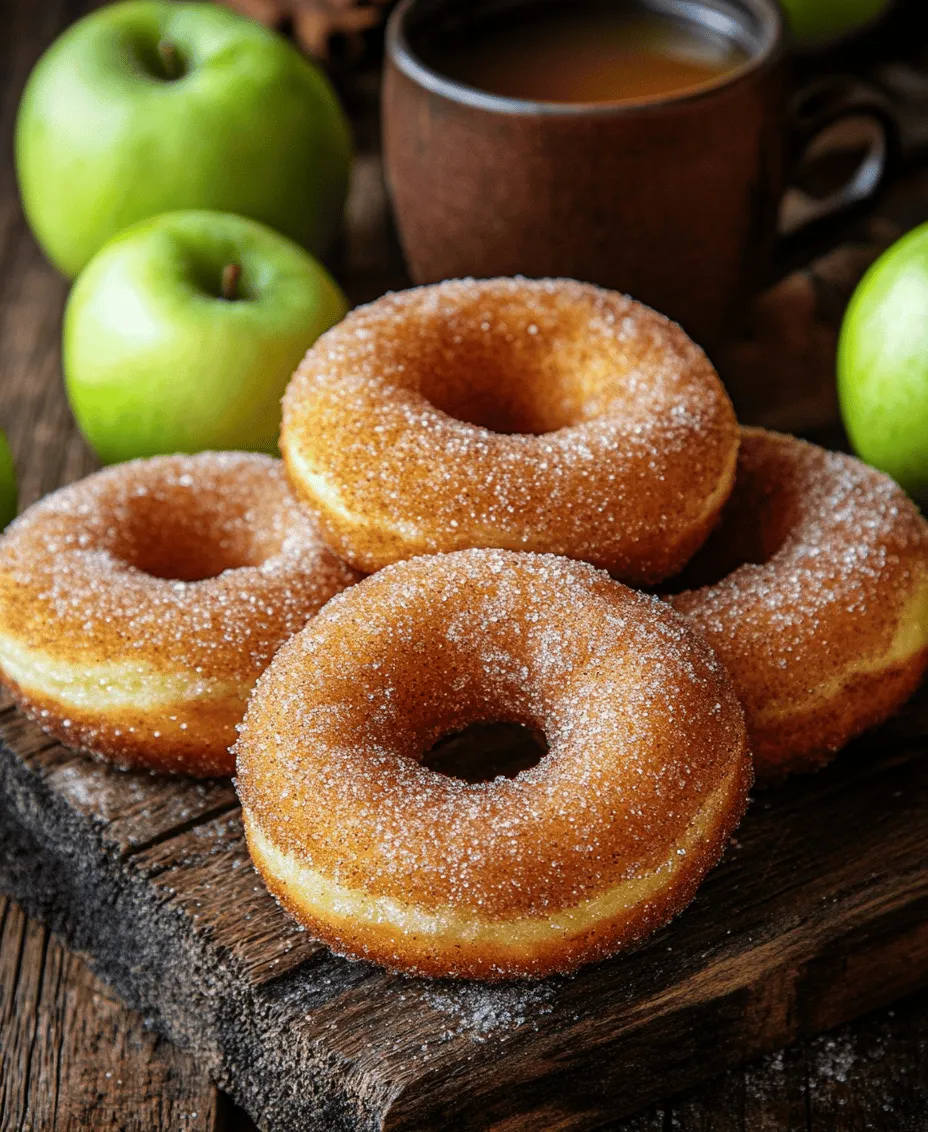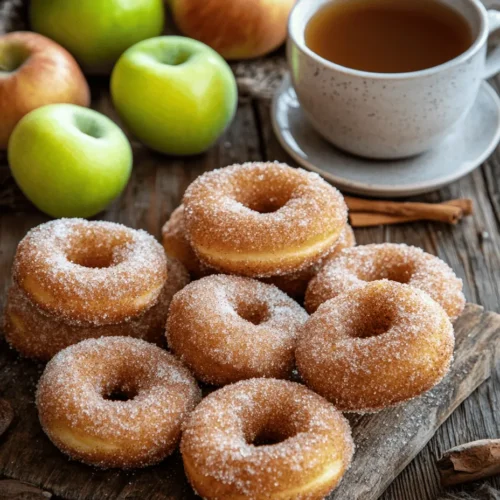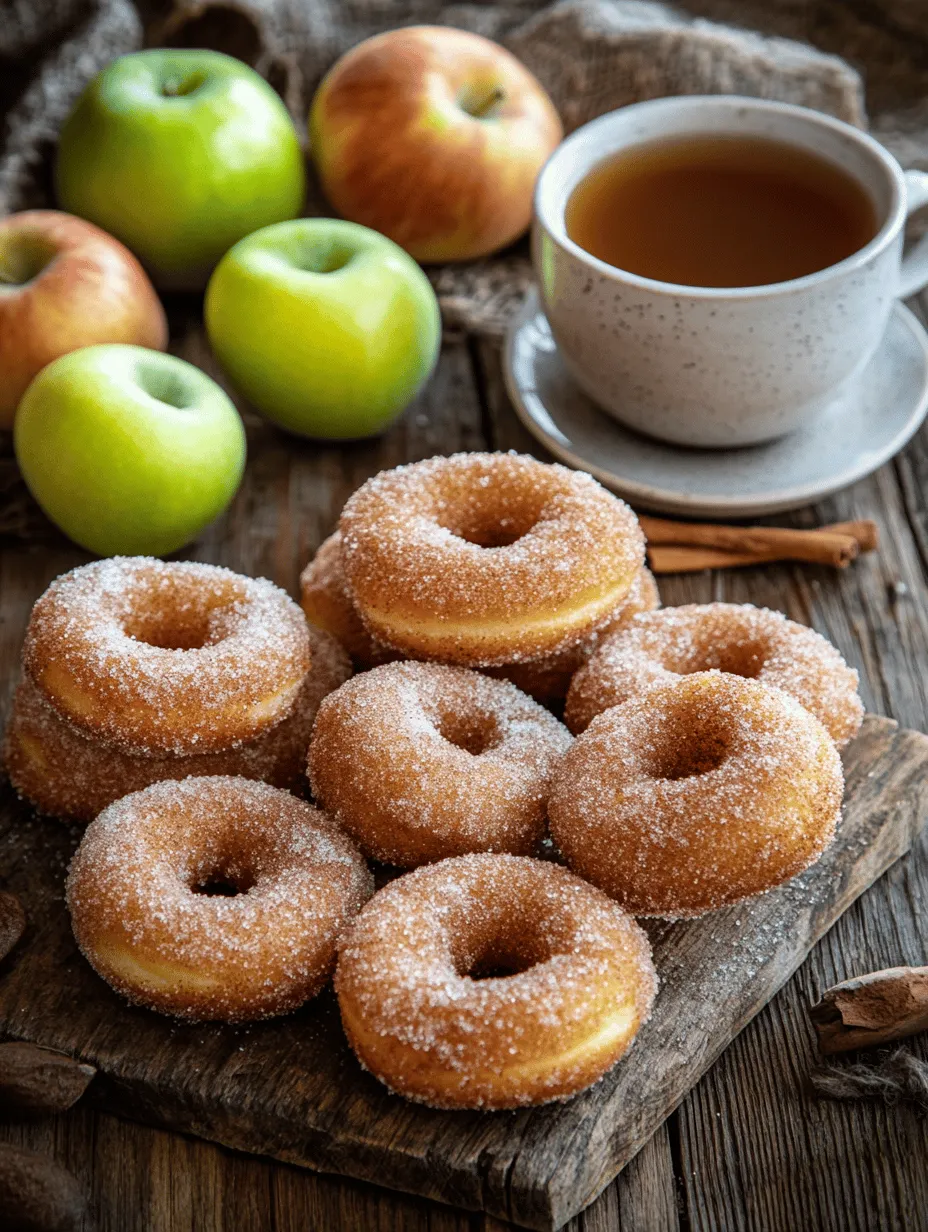As the leaves begin to change and the air turns crisp, the scent of warm spices and sweet apples wafts through bakeries and kitchens alike, signaling the arrival of fall. Among the many seasonal treats, apple cider donuts stand out as a beloved favorite. These delightful pastries capture the essence of autumn with each bite, intertwining the rich flavor of apple cider with a hint of cinnamon, nutmeg, and ginger. Whether served at a cozy gathering or enjoyed as a special breakfast treat, apple cider donuts are the perfect way to celebrate the season.
In this guide, we will walk you through creating your own irresistible apple cider donuts from scratch. We will provide detailed insights into each ingredient and step involved, ensuring that you achieve the perfect texture and flavor. By the end of this article, you will feel confident in your baking skills and ready to impress your friends and family with a batch of homemade apple cider donuts.
Understanding the Ingredients
To craft the perfect apple cider donuts, it’s essential to understand the role each ingredient plays in the recipe. Let’s delve into the key components that contribute to the flavor and texture of these delectable treats.
The Role of Apple Cider in Flavor Development
Apple cider is the star ingredient in this recipe, providing a deep, rich apple flavor that is both sweet and slightly tangy. When reduced, apple cider becomes even more concentrated, enhancing its sweetness and intensifying the flavors. This reduction process not only amplifies the cider’s natural sugars but also helps to create a moist and tender donut. When selecting apple cider, opt for high-quality, unfiltered varieties for the best flavor impact.
Sweeteners: Granulated vs. Brown Sugar
In apple cider donuts, the choice of sweetener can significantly affect the overall taste. Granulated sugar is commonly used for its clean sweetness, while brown sugar adds a subtle molasses flavor and moisture to the donuts. A combination of both sugars can create a balanced sweetness that complements the apple cider and spices beautifully. Using brown sugar can also contribute to a deeper color and richer flavor profile, making your donuts even more irresistible.
Importance of Butter for Richness
Butter is a crucial ingredient in baking, and its role in apple cider donuts is no exception. It adds richness, moisture, and flavor to the batter. When creamed with sugar, butter helps to aerate the mixture, resulting in a light and fluffy texture. For the best results, use unsalted butter to control the saltiness in your recipe. Allowing the butter to come to room temperature before mixing will ensure it incorporates smoothly, creating a uniform batter.
The Function of Eggs in Baking
Eggs are essential in baking for several reasons. They provide structure, stability, and moisture to baked goods. In apple cider donuts, eggs help bind the ingredients together, ensuring the donuts hold their shape while baking. They also contribute to the tender crumb and add richness to the flavor. For this recipe, using large eggs is standard, but make sure they are at room temperature for optimal mixing.
Spices: Cinnamon, Nutmeg, and Ginger
The warm spices used in apple cider donuts are what make them truly special. Cinnamon is a classic choice, providing warmth and sweetness. Nutmeg adds a slightly nutty flavor, while ginger brings a hint of warmth and zest. Together, these spices evoke the comforting flavors of fall, making each bite of the donut feel like a warm embrace. Adjust the spice levels according to your preference, but a balance of all three is recommended for an authentic taste.
The Role of Flour and Leavening Agents
Flour serves as the primary structure in apple cider donuts, while leavening agents like baking powder and baking soda create the right amount of lift. All-purpose flour is typically used for its balanced protein content, which contributes to a tender yet sturdy donut. The leavening agents work together to ensure your donuts rise properly during baking, resulting in a fluffy texture. Be sure to measure your flour accurately, as too much can lead to a dense donut.
Preparation Steps for Perfect Apple Cider Donuts
Now that we’ve covered the essential ingredients, it’s time to prepare your kitchen for success. Follow these steps to ensure your apple cider donuts turn out perfect every time.
Essential Baking Equipment Needed
Before you dive into the recipe, gather all the necessary equipment to streamline your baking process. Here’s what you will need:
– Donut Pan: A non-stick donut pan is essential for shaping your donuts. If you don’t have one, consider investing in a good quality silicone mold, which makes it easy to release the donuts after baking.
– Mixing Bowls: Use multiple mixing bowls for combining wet and dry ingredients separately. This helps ensure an even distribution of flavors and textures.
– Whisk and Spatula: A whisk is necessary for mixing the dry ingredients and ensuring they are well combined. A spatula will come in handy for folding the wet and dry mixtures together without overmixing.
– Measuring Cups and Spoons: Accurate measurements are vital in baking, so make sure to have both dry and liquid measuring tools on hand.
– Cooling Rack: Once baked, your donuts will need to cool. A cooling rack allows air to circulate around the donuts, preventing them from becoming soggy.
Importance of Preheating the Oven
Preheating your oven is a crucial step that should never be overlooked. It ensures that your donuts bake evenly and rise properly. The optimal temperature for baking apple cider donuts is typically around 350°F (175°C). While you prepare your batter, allow your oven to preheat fully to achieve the best results.
Preparing Your Donut Pan
Before pouring in the batter, it’s essential to prepare your donut pan to prevent sticking. If you’re using a non-stick pan, a light spray of cooking oil can help ensure easy removal. For added security, consider dusting the pan with flour after spraying it. If you’re using a silicone mold, a quick rinse with water should suffice, as these molds generally release baked goods more easily.
How to Reduce Apple Cider Effectively
One of the key steps in creating flavorful apple cider donuts is reducing the apple cider to concentrate its flavor. This process enhances the sweetness and intensifies the apple flavor, making a significant difference in the final product.
Step-by-Step Guide to Reducing Apple Cider
1. Pour the Cider into a Saucepan: Start by measuring out the amount of apple cider required for your recipe and pour it into a medium-sized saucepan.
2. Bring to a Boil: Place the saucepan over medium-high heat and bring the cider to a gentle boil. Be sure to stir occasionally to prevent it from sticking to the bottom.
3. Reduce the Heat: Once boiling, reduce the heat to medium-low and let the cider simmer. This process will gradually evaporate the water content, concentrating the flavors.
4. Monitor the Consistency: Keep an eye on the cider as it reduces. You’re looking for a syrup-like consistency, which typically takes about 10-15 minutes of simmering. It should be thick enough to coat the back of a spoon.
5. Cool and Measure: Once the cider has reduced, remove it from the heat and let it cool before measuring the amount needed for your donut batter.
Tips for Achieving the Right Consistency
– Use a Wide Pan: A wider saucepan allows for greater evaporation, speeding up the reduction process.
– Avoid Overcooking: Keep an eye on the cider to ensure it doesn’t caramelize or burn. If it starts to darken too much, remove it from the heat immediately.
– Taste Test: As the cider reduces, taste it occasionally to gauge the flavor. You want it to be sweet and full of apple character, without any bitterness.
Mixing Wet Ingredients for Flavor
With your apple cider reduced and your kitchen prepped, it’s time to mix the wet ingredients that will bring your donuts to life.
Combining Sugars and Butter: The Creaming Method
1. Cream the Butter and Sugars Together: In a large mixing bowl, combine the softened butter, granulated sugar, and brown sugar. Using an electric mixer, beat them together on medium speed until the mixture is light and fluffy. This process usually takes about 2-3 minutes.
2. Add the Eggs: Once the butter and sugars are well combined, add the eggs, one at a time, mixing well after each addition. This ensures that the eggs are fully incorporated, resulting in a smooth batter.
3. Incorporate Vanilla Extract: After the eggs are mixed in, add a splash of vanilla extract. This will enhance the overall flavor of your donuts and complement the apple cider beautifully.
The Importance of Incorporating Eggs and Vanilla
Incorporating eggs and vanilla at this stage is crucial for creating a cohesive batter. Eggs provide the necessary structure and moisture, while vanilla adds a layer of flavor that enhances the sweetness of the donuts. Make sure to mix until the wet ingredients are thoroughly combined to ensure an even distribution of flavors throughout the batter.
Creating the Perfect Donut Batter
Once your wet ingredients are ready, it’s time to combine them with the dry ingredients to create the perfect donut batter. This step is essential to achieving the right texture and flavor balance in your apple cider donuts.
Stay tuned for the next part of this article, where we will dive into mixing the dry ingredients, folding everything together, and baking your delicious apple cider donuts to perfection!

Sifting Dry Ingredients: Why It Matters
Sifting dry ingredients is a crucial step in baking, especially for our irresistible apple cider donuts. This technique aerates the flour, ensuring that your donuts have a light and fluffy texture. Sifting helps to break up clumps and evenly blend ingredients like baking powder, baking soda, and spices, which can affect the overall rise of the donuts. By incorporating air into the dry mix, you create a batter that will expand beautifully in the oven, resulting in tender, well-structured donuts.
Moreover, sifting also helps to remove any impurities or lumps from the flour, ensuring a smooth batter. If you want to take your baking to the next level, consider sifting your dry ingredients twice. This extra step can make a noticeable difference in the final texture of your donuts, giving them that melt-in-your-mouth quality everyone craves.
Folding Techniques for a Light Texture
Once your dry ingredients are sifted, it’s time to combine them with your wet ingredients. The key to achieving the desired light and airy texture lies in the folding technique. Unlike stirring or beating, which can develop gluten and lead to dense donuts, folding gently incorporates the ingredients without overmixing.
To fold effectively, use a spatula or a wooden spoon to cut through the center of the batter, then scoop from the bottom and fold over the top. Rotate the bowl as you go, ensuring that you incorporate the ingredients evenly. Be patient and stop folding as soon as you no longer see dry flour. A few small lumps in the batter are perfectly fine; they will dissolve during baking, and overmixing is a common mistake that can lead to rubbery donuts.
Common Mistakes to Avoid When Mixing
When preparing the batter for your apple cider donuts, a few common mistakes can hinder your results. Here are some pitfalls to avoid:
1. Overmixing the Batter: As discussed, mixing too vigorously can lead to tough donuts. Always opt for gentle folding to maintain the batter’s lightness.
2. Incorrect Ingredient Temperatures: Ensure your butter and eggs are at room temperature before mixing. Cold ingredients can lead to an uneven batter and prevent proper emulsification.
3. Using the Wrong Flour: For the best results, use all-purpose flour. Cake flour will yield a different texture, while bread flour may make your donuts too dense.
4. Not Measuring Ingredients Accurately: Baking is a science, and precise measurements matter. Use a kitchen scale for the most accurate results, especially for flour.
5. Ignoring the Recipe: While it can be tempting to make substitutions, sticking to the recipe will ensure you achieve the intended flavor and texture.
Baking Your Donuts to Perfection
Filling the Donut Pan
Now that your batter is ready, it’s time to fill the donut pan. Properly filling the pan is essential for achieving perfectly shaped donuts.
How to Spoon Batter Without Making a Mess:
To avoid a messy situation, you can use a piping bag or a zip-top bag with a corner snipped off. This allows for controlled pouring into the donut pan. Alternatively, you can use a small ice cream scoop or spoon, but be sure to fill each cavity only about halfway full. This allows space for the donuts to rise while baking.
Tips for Achieving Evenly Shaped Donuts:
For uniformly shaped donuts, make sure you fill each cavity with the same amount of batter. If you’re using a scoop, one level scoop per cavity usually works well. After filling, gently tap the pan on the counter to release any air bubbles and help the batter settle evenly.
Baking Time and Temperature
The baking temperature for your apple cider donuts is typically set at 350°F (175°C). This is a great balance that allows the donuts to rise without burning.
Understanding Donut Doneness:
Donuts usually take about 10-12 minutes to bake, but keep an eye on them. You want the edges to be golden brown, and the tops should spring back when lightly pressed.
The Toothpick Test Explained:
A reliable way to ensure your donuts are done is by using the toothpick test. Insert a toothpick into the center of a donut; if it comes out clean or with a few moist crumbs, your donuts are ready. If it comes out wet, give them a few more minutes and check again.
Cooling and Coating Your Donuts
Proper Cooling Techniques
Once your donuts are baked to perfection, it’s crucial to cool them properly. Remove the pan from the oven and allow it to cool for about 5 minutes. Then, carefully transfer the donuts to a wire rack. Cooling on a rack allows air to circulate around the donuts, preventing them from becoming soggy on the bottom.
Making the Cinnamon-Sugar Coating
The delightful cinnamon-sugar coating is what takes your apple cider donuts to the next level. For this, you’ll need granulated sugar and ground cinnamon. The general ratio is about 1 cup of sugar to 2 tablespoons of cinnamon, but you can adjust this based on your preference.
To coat the donuts, melt a little butter in a shallow dish. Once the donuts are cool enough to handle, dip each one in the melted butter, then roll it in the cinnamon-sugar mixture until fully coated. This step adds flavor and an irresistible crunch to every bite.
Serving and Enjoying Apple Cider Donuts
Best Ways to Serve Your Donuts
There are many delightful ways to serve your apple cider donuts. These treats can be enjoyed fresh out of the oven, still warm, or you can let them cool to room temperature.
Serving Suggestions for Different Occasions:
– Fall Gatherings: Present them on a platter at your next gathering, paired with caramel or chocolate sauce for dipping.
– Breakfast or Brunch: Serve them alongside a fresh fruit salad or a yogurt parfait for a complete breakfast.
– Holiday Treats: Package them in decorative boxes as gifts for friends and family during the holiday season.
Pairing with Beverages: Coffee, Tea, or Cider
To enhance your apple cider donut experience, consider pairing them with beverages that complement their flavors. A hot cup of coffee or tea balances the sweetness and warmth of the donuts. For a more seasonal touch, serving them with apple cider, whether hot or cold, creates a harmonious flavor experience that celebrates autumn.
Storage Tips for Freshness
How to Store Leftover Donuts
If you happen to have leftovers (a rare occurrence with these delicious donuts), it’s essential to store them properly to maintain their freshness. Place the donuts in an airtight container at room temperature. They’ll stay fresh for up to three days. Avoid refrigerating them, as this can make them dry.
Freezing Options for Future Enjoyment
For longer storage, consider freezing your apple cider donuts. Allow them to cool completely, then place them in a single layer on a baking sheet and freeze until solid. Once frozen, transfer the donuts to an airtight freezer bag or container. They can be stored in the freezer for up to three months. When ready to enjoy, thaw them at room temperature and warm them in the oven for a few minutes to restore their delightful texture.
Conclusion: Relishing Your Homemade Apple Cider Donuts
Making homemade apple cider donuts is a rewarding experience that brings the flavors of autumn into your kitchen. With careful attention to detail in both the ingredients and the preparation process, you can achieve a batch of donuts that is both tender and bursting with flavor. Whether enjoyed warm out of the oven or shared among friends, these donuts are sure to become a cherished treat in your home.
The next time you crave something sweet, remember that homemade apple cider donuts are just a few steps away. Indulge in the comforting tastes of cinnamon and apple, and relish the satisfaction of creating a delightful dessert that will impress your family and friends. Happy baking!



